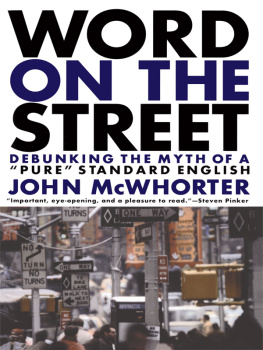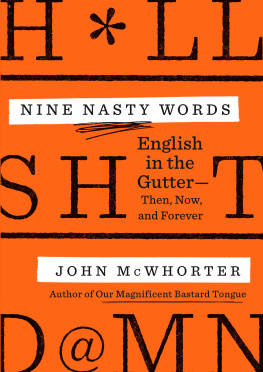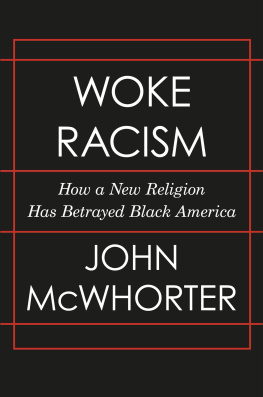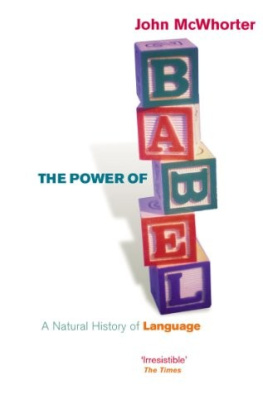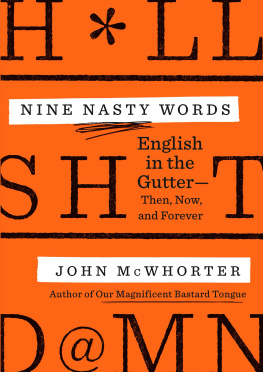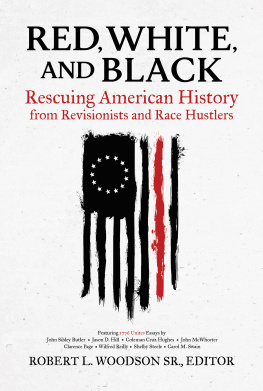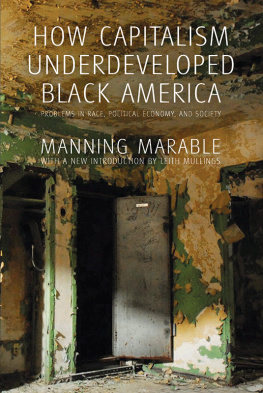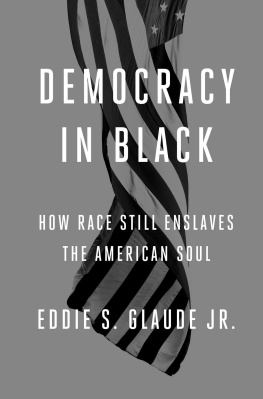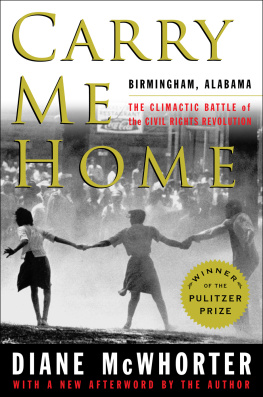The Missing Spanish Creoles: Recovering the Birth of Plantation Contact Languages
Doing Our Own Thing: The Degradation of Language and Music and Why We Should, Like, Care
WINNING THE RACE
Beyond the Crisis in Black America
J OHN M C WHORTER

GOTHAM BOOKS
Published by Penguin Group (USA) Inc.
375 Hudson Street, New York, New York 10014, U.S.A.
Penguin Group (Canada), 90 Eglinton Avenue East, Suite 700, Toronto, Ontario,
Canada M4P 2Y3 (a division of Pearson Penguin Canada Inc.); Penguin Books Ltd,
80 Strand, London WC2R 0RL, England; Penguin Ireland, 25 St Stephens Green,
Dublin 2, Ireland (a division of Penguin Books Ltd);
Penguin Group (Australia), 250
Camberwell Road, Camberwell, Victoria 3124, Australia (a division of Pearson Australia
Group Pty Ltd);
Penguin Books India Pvt Ltd, 11 Community Centre,
Panchsheel Park, New Delhi-110 017, India; Penguin Group (NZ), cnr Airborne and
Rosedale Roads, Albany, Auckland 1310, New Zealand (a division of Pearson New
Zealand Ltd); Penguin Books (South Africa) (Pty) Ltd, 24 Sturdee Avenue, Rosebank,
Johannesburg 2196, South Africa
Penguin Books Ltd, Registered Offices: 80 Strand, London WC2R 0RL, England
Published by Gotham Books, a division of Penguin Group (USA) Inc.
Copyright 2005 by John McWhorter
All rights reserved
Gotham Books and the skyscraper logo are trademarks of Penguin Group (USA) Inc.
Library of Congress Cataloging-in-Publication Data
McWhorter, John H.
Winning the race / John McWhorter.
p. cm.
Includes bibliographical references (p. ).
ISBN: 978-1-1012-1677-4
1. African AmericansSocial conditions1975 2. African AmericansPsychology. 3. Alienation (Social psychology)United States. 4. Inner citiesUnited States. 5. African AmericansEconomic conditions. 6. United StatesRace relations. I. Title.
E185.86.M427 2006
305.896'073dc22 2005023472
Without limiting the rights under copyright reserved above, no part of this publication may be reproduced, stored in or introduced into a retrieval system, or transmitted, in any form, or by any means (electronic, mechanical, photocopying, recording, or otherwise), without the prior written permission of both the copyright owner and the above publisher of this book.
Contents
The Birth of the Inner City: The Conventional Wisdom
The Birth of the Inner City, Part One: Indianapolis
The Birth of the Inner City, Part Two: The Saga
Why Are You Talking About Blacks on Welfare?
The Meme of Therapeutic Alienation: Defined by Defiance
What About Black Middle-Class Rage?
What About the View from the Ivory Tower?
Therapeutic Alienation Meets Hitting the Books: Acting White and Affirmative Action Revisited
The Hip-Hop Revolution: Therapeutic Alienation on a Rhythm Track
Therapeutic Alienation as a Plan of Action? New Black Leadership for New Negroes
Conclusion
Introduction
C ondoleezza Rice and Colin Powell? Well, good for them.
There are more middle-class black families than poor ones? Well, okaybut still.
There are eight times more black-white married couples than there were in 1960? Yes, but.
The editor in chief of Newsweek , the president of Brown University, and the CEO of AOL-Time Warner are black people? Nigger, please.
There is so much good news in black America today that if we could transport a black American into our era from even as recently as the 1960s, they would wonder whether some trick had been played. But in certain quarters of black America, people are almost embarrassed to see such things brought up and can only celebrate them in a backhanded fashion. These people, as well as white fellow travellers, give the impression that if race conditions improved to the point that it would no longer make sense to say Weve come a long way, but we have a long way to go, they wouldnt quite know what to do with themselves and would even be a little irritated.
Stanley Crouch tells us, One should always keep a hot poker ready for the backside of injustice, but it is important to polish the crown when youve damned well earned it. Yet so many find it distasteful to even go near that crown, much less polish itat least in public.
What they want us to think about is Robert Parsons.
On a June night in 2005, Parsons, a black father of four, was at a barbecue on a public playground in Brooklyn. Two men drove up and suggested a private conversation in a grassy area not far from the playground. The first gunshot got Parsons in the stomach. The force spun him around and the murderer finished Parsons off with a shot in the back. He died at the hospital.
Parsons was hoping to make a mark as a rapper, and to the best of peoples knowledge, the people who killed him, who were rappers as well, decided they could use a little less competition. Or maybe they had mistaken him for someone else. In any case, he would have had his thirtieth birthday two days later. Its like Im walking around without a heart anymore, his mother said.
Parsonss murder took place in a struggling ghetto setting sadly familiar to us all. In his case, it was Brooklyns Crown Heights, infamous as the neighborhood where in 1991 blacks rioted for days and killed a young Jewish scholar after a young black boy was killed by a Hasid in a traffic accident. Looming over the playground was the Ebbets Field Apartment housing project, hideous twenty-five-story towers plain and tall that, bafflingly today, passed as visionary public architecture in the early 1960s when they were thrown up (so to speak). The project was built for low-income people, and there is no shortage of them in the district they are in: Every fourth person in the zip code lives below the poverty level. Crown Heights has been one of the neighborhoods identified by the New York City Health Department as most in need of aid for substance abusers. Segregation? Indeedthe area where Parsons died is 85 percent black.
That the middle school near the housing project is named after icon of integration Jackie Robinson qualifies as an irony today. Middle School 320 has been one of those tragic inner-city schools we hear so much about, with the graffiti, the broken windows, and the threatened takeover by Edison. At one point it had a single guidance counselor for 1,400 kids, and it has had an extended school-day program aimed at distracting students from violence.
And then, Parsonss murder was, as it happened, one in a string of three that took place in blue-collar black New York that week. Two days before, fifteen-year-old Phoenix Garrett was selling homemade CDs in West Harlem when a thirteen-year-old from Queens shot him dead after an argument; the killer sat unfazed at his arraignment. Then, the day after Parsons was killed, just twenty blocks from where Garrett died, a twenty-one-year-old black man was shot dead while waiting for his food at a McDonalds.
SoCondoleezza Rice, Brown University, jungle fever marriages? Mere abstractions in Crown Heights, which is, we are often told, the real state of black America.
And that means that there is still, as Randall Robinson so deftly had it in the title of his best seller of 2000, a debt that America owes to black people despite the Civil Rights Act of 1964. The American government did not do enough, the argument goes. Black America needs a Second Civil Rights Revolution.


